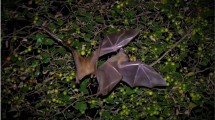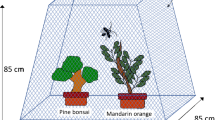Abstract
We performed field tests using mimetic Piper fruits with and without essential oil extracted through hydrodistillation from Piper gaudichaudianum ripe fruits in order to evaluate the role of odor in Carollia perspicillata attraction and capture in mist-nets. During the field tests, 26 C. perspicillata were captured, 21 (80.7%) in nets with the essential oil of P. gaudichaudianum and five (19.3%) in nets without oil. Other bat species, Artibeus spp. (67), which is specialized on fruits of Moraceae, and Sturnira lilium (10), specialized on those of Solanaceae, were also captured, but they exhibited no significant preference for nets with or without oil. We conclude that odor is pre-eminent over visual cues in food location by C. perspicillata in a field situation. Based on the result, we propose the extraction and use of essential oils of chiropterochoric fruits as a useful approach to improve autoecological studies on fruit-eating bats and to promote tropical forest restoration through the attraction of frugivorous bats to degraded areas.
Similar content being viewed by others
References
Bhatnagar, K. P. and Kallen, F. C. 1975. Quantitative observations on the nasal epithelia and olfactory innervation in bats. Acta Anat. 91:272–282.
Fleming, T. H. 1998. The Short-Tailed Fruit Bat: A Study of Plant-Animal Interactions. University of Chicago Press, Chicago.
Fleming, T. H., Heithaus, E. R., and Sawyer, W. B. 1977. An experimental analysis of the food location behavior of frugivorous bats. Ecology. 58:619–627.
Laska, M. 1990. Olfactory discrimination ability in short-tailed fruit bat, Carollia perspicillata (Chiroptera: Phyllostomidae). J. Chem. Ecol. 16:3291–3299.
Medellin, R. A. and Gaona, O. 1999. Seed dispersal by bats and birds in forest and disturbed habitats of Chiapas, México. Biotropica. 31:478–485.
Mikich, S. B. 2002. A dieta dos morcegos frugívoros (Mammalia, Chiroptera, Phyllostomidae) de um pequeno remanescente de Floresta Estacional Semidecidual do sul do Brasil. Revta bras. Zool. 19:239–249.
Mikich, S. B. and Silva, S. M. 2001. Composicão florística e fenologia das espécies zoocóricas de remanescentes de Floresta Estacional Semidecidual no centro-oeste do Paraná, Brasil. Acta bot. brasíl. 15:89–113.
Rieger, J. M. and Jakob, E. M. 1988. The use of olfaction in food location by frugivorous bats. Biotropica. 20:161–164.
Thies, W., Kalko, E. K. V., and Schnitzler, H.-U. 1998. The roles of echolocation and olfaction in two Neotropical fruit-eating bats, Carollia perspicillata and C. castanea, feeding on Piper. Behav. Ecol. Sociobiol. 42:397–409.
Van Der Pijl, L. 1957. The dispersal of plants by bats (chiropterochory). Acta Botanica Neerlandica. 6:291–315.
Author information
Authors and Affiliations
Corresponding author
Rights and permissions
About this article
Cite this article
Mikich, S.B., Bianconi, G.V., Maia, B.H.L.N.S. et al. Attraction of the Fruit-Eating Bat Carollia perspicillata to Piper gaudichaudianum Essential Oil. J Chem Ecol 29, 2379–2383 (2003). https://doi.org/10.1023/A:1026290022642
Issue Date:
DOI: https://doi.org/10.1023/A:1026290022642




